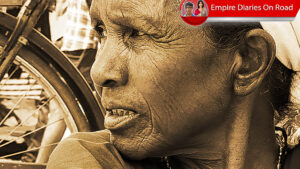COLUMN/ THE WRITE LINE
By Colin Todhunter
In light of the current Covid-related situation in India, Dr Anthony Fauci, the top US adviser on Covid, has called for India to implement a hard lockdown and for the mass roll-out of vaccines.
‘However, Fauci has no clue and no authority to lecture on what is good for India’.
That is the view of Empire Diaries website, which argues that the US is a rich nation, prints the world’s reserve currency, has robust financial coverage for the jobless and its population is spread out.
On the other hand, India is finance-strained, has a brittle economy that lives on the brink of disaster, does not have any financial coverage for the jobless, is densely populated and its people mostly live in congested clusters.
Given the government’s incompetence and the callousness demonstrated towards poorer sections of Indian society the first time around, Empire Diaries writes any new lockdown would again result in disaster. It adds that nothing has been learnt, with no attempt to upgrade the healthcare set-up nationwide.
Will India be able to bear another scar of sudden lockdown?
It is worth recalling what renowned academic and activist Noam Chomsky said about India’s first lockdown.
During an interview with Amy Goodman of Democracy Now! back in May 2020, Chomsky said: “You can almost describe it as genocidal. Modi gave, I think, a four-hour warning before a total lockdown. That’s [affected] over a billion people. Some of them have nowhere to go.”
He added, “People in the informal economy, which is a huge number of people, are just cast out. Go walk back to your village, which may be a thousand miles away. Die on the roadside. This is a huge catastrophe in the making…”
During the first lockdown in India, rural affairs commentator P Sainath painted a dreary picture of the impacts, not least the desperate plight of migrant workers, a shortage of cash to buy food and a potential shortage of food as farmers were unable to complete their harvests.
Sainath also reported the views of Dr. Sundararaman, a former executive director of the National Health Systems Resources Centre, who argued that there was a desperate need to: “Identify and act on the reverse migrations problem and the loss of livelihoods. Failing that, deaths from diseases that have long tormented mostly poor Indians could outstrip those brought about by the corona virus.”
Regardless of the destructive impact of the first lockdown in India and the questionable efficacy of lockdowns in terms of what they are supposed to achieve, another one would further push hundreds of millions towards poverty and hunger. It would merely fuel and accelerate the impoverishment caused by the first lockdown.
A new report prepared by the Centre for Sustainable Employment at Azim Premji University (APU) has highlighted how employment and income had not recovered to pre-pandemic levels even by late 2020.
The report, ‘State of Working India 2021 – One year of Covid-19’ highlights how almost half of formal salaried workers moved into the informal sector and that 230 million people fell below the national minimum wage poverty line.
Even before Covid, India was experiencing its longest economic slowdown since 1991 with weak employment generation, uneven development and a largely informal economy.
A recent article by the Research Unit for Political Economy highlights the structural weaknesses of the economy and the often desperate plight of ordinary people.
The study also found that there was a loss in monthly earnings for all types of workers: 13% for casual workers, 18% for the self-employed, 17% for those with temporary salaries, 5% for the permanent salaried and 17% overall.
The poorest 25% of households borrowed 3.8 times their median income, as against 1.4 times for the top 25%. The study noted the implications for debt traps.
Six months later, it was also noted that food intake was still at lockdown levels for 20% of vulnerable households.
SENSATIONALISM?
Given this impact, before listening to prominent individuals with apparent conflicts of interest related to vaccine roll-outs (see the editorial in the British Medical Journal ‘Covid-19, Politicisation, Corruption, and Suppression of Science’), the current COVID-related situation in India must be contextualised.
According to Yohan Tengra, a Mumbai-based political analyst and healthcare specialist, the true number of infection rates can only be known by testing symptomatic people who have tested positive with either a virus culture test or PCR test that uses 24 cycles or less.
The PCR test has been used as the gold standard for Covid cases around the world. But it has been sharply criticised for being inaccurate, inappropriate, for using cycles in excess of 40 (thereby inflating the numbers) and for producing ‘false positives’.
It seems that even the Swedish ministry of health now thinks that it is not fit for purpose:
“The PCR technology used in tests to detect viruses cannot distinguish between viruses capable of infecting cells and viruses that have been neutralised by the immune system and therefore these tests cannot be used to determine whether someone is contagious or not. RNA from viruses can often be detected for weeks (sometimes months) after the illness but does not mean that you are still contagious.”
We also need to be reminded what the US Centers for Disease Control and Prevention (CDC) stated about the PCR in December 2020. It is especially important to focus on PCR testing because these tests are the entire basis for restrictions and lockdowns (and vaccination); even when deaths were within normal annual ranges, ‘case’ levels were high and restrictions and ‘tiered lockdowns’ were still being imposed in places like the UK.
The following extract can be found on page 39 of the report from the CDC 2010-Novel Coronavirus (2019-nCoV) Real-Time RT-PCR Diagnostic Panel:
“Detection of viral RNA may not indicate the presence of infectious virus or that 2019-nCoV is the causative agent for clinical symptoms. This test cannot rule out diseases caused by other bacterial or viral pathogens.”
THE VACCINE QUESTION
If the pandemic narrative has been constructed on the house of (statistical) cards outlined thus far, then we should be questioning the need for a mass vaccination campaign.
This is not lost on Dr Geert Vanden Bossche, a virologist who has held positions at several vaccine companies, carrying out vaccine research and development. He has also been involved with the Bill and Melinda Gates Foundation and has worked with the Global Alliance for Vaccines and Immunization (GAVI). Not an ‘anti-vaxxer’ in any sense of the term.
He offers insight into why it is quite possible that mass vaccine rollouts will actually lead to very disturbing levels of deaths directly related to Covid-19. Far from reducing the numbers and facilitating immunity, he anticipates ‘vaccine mitigated immune escape’.
Vanden Bossche warns that mass infection prevention and mass vaccination with Covid-19 vaccines in the midst of the pandemic can only breed highly infectious variants. He offers a truly worrying scenario. Of course, not everyone might agree with his analysis but it is certainly a cause for concern.
There is also the entire issue regarding the necessity, efficacy and safety of the vaccines now being rolled out. The group ‘Doctors for Covid Ethics’ has recently raised serious doubts in all of these areas (its concerns have been published on the UK-based OffGuardian website).
In finishing, there are two questions we should ask.
Can we have confidence in science and evidence-based health and social policy where Covid-19 is concerned? And can we just assume – as governments and the media imply we should – that Anthony Fauci and the pharmaceutical corporations have ordinary people’s interests at heart?
In response to the first question, not much. In response to the second, certain interests have been riding and fuelling a wave of sensationalism and duplicity throughout.
(Views expressed in the opinion piece are the columnist’s personal observations)
Please SUBSCRIBE AND CLICK ON THE BELL ICON to get all the updates from our YouTube channel.
Please follow us on Facebook
Pl subscribe and support our effort to keep information independent.










